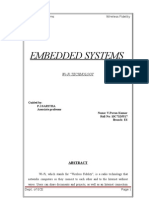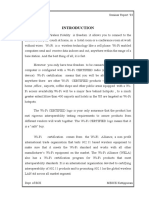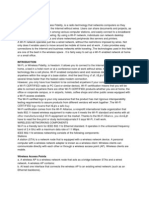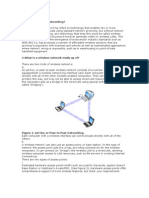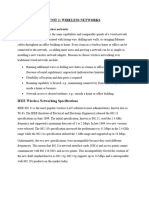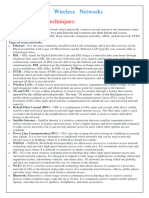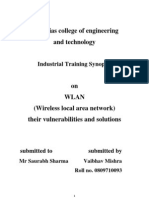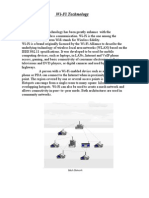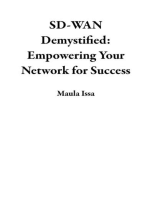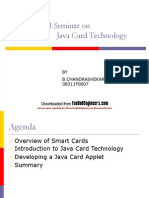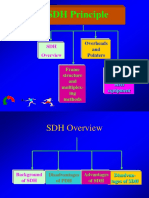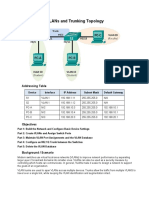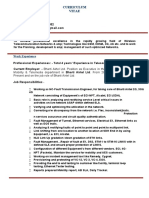Wireless Fidelity Seminar Report 03
Wireless Fidelity Seminar Report 03
Uploaded by
Surangma ParasharCopyright:
Available Formats
Wireless Fidelity Seminar Report 03
Wireless Fidelity Seminar Report 03
Uploaded by
Surangma ParasharOriginal Title
Copyright
Available Formats
Share this document
Did you find this document useful?
Is this content inappropriate?
Copyright:
Available Formats
Wireless Fidelity Seminar Report 03
Wireless Fidelity Seminar Report 03
Uploaded by
Surangma ParasharCopyright:
Available Formats
Wireless Fidelity
Seminar Report 03
INTRODUCTION
Wi-Fi, or Wireless Fidelity is freedom :it allows you to connect to the internet from your couch at home, in a hotel room or a conferance room at work without wires . Wi-Fi is a wireless technology like a cell phone. Wi-Fi enabled computers send and receive data indoors and out; anywhere within the range of a base station. And the best thing of all, it is fast. However you only have true freedom to be connected any where if your computer is configured with a Wi-Fi CERTIFIED radio (a PC card or similar device). Wi-Fi certification means that you will be able able to connect anywhere there are other Wi-Fi CERTIFIED products whether you are at home ,office , airports, coffee shops and other public areas equipped with a WiFi access availability.Wi-Fi will be a major face behind hotspots , to a much greater extent.More than 400 airports and hotels in the US are targeted as Wi-Fi hotspots. The Wi-Fi CERTIFIED logo is your only assurance that the product has met rigorous interoperability testing requirements to assure products from different vendors will work together. The Wi-Fi CERTIFIED logo means that it is a safe buy.
Wi-Fi
certification comes from the Wi-Fi Alliance, a non profit
international trade organisation that tests 802.11 based wireless equipment to make sure that it meets the Wi-Fi standard and works with all other manufacturers Wi-Fi equipment on the market. The Wi-Fi Alliance (WELA) also has a Wi-Fi certification program for Wi-Fi products that meet interoperability standards. It is an international organisation devoted to certifying interoperability of 802.11 products and to promoting 802.11as the global wireless LAN std across all market segment.
Dept. of ECE -1MESCE Kuttippuram
Wireless Fidelity
Seminar Report 03
IEEE 802.11 ARCHITECTURES
In IEEE's proposed standard for wireless LANs (IEEE 802.11), there are two different ways to configure a network: ad-hoc and infrastructure. In the adhoc network, computers are brought together to form a network "on the fly." As shown in Figure 1, there is no structure to the network; there are no fixed points; and usually every node is able to communicate with every other node. A good example of this is the aforementioned meeting where employees bring laptop computers together to communicate and share design or financial information. Although it seems that order would be difficult to maintain in this type of network, algorithms such as the spokesman election algorithm (SEA) [4] have been designed to "elect" one machine as the base station (master) of the network with the others being slaves. Another algorithm in ad-hoc network architectures uses a broadcast and flooding method to all other nodes to establish who's who.
Dept. of ECE
-2-
MESCE Kuttippuram
Wireless Fidelity
Seminar Report 03
Figure 1a: The ad-hoc network structure in the 802.11 protocol.
The ad-hoc network (Figure 1a) is one formed from a collection of peer nodes all using RF links. This network has no formal structure; all nodes can communicate with all other nodes. Several algorithms are available to prevent this from being total chaos, however, including a spokesman election algorithm that selects a master from the collective and makes all others slaves. Another possibility is to use broadcast and flooding to all other nodes to establish an addressing scheme. A good example of an ad-hoc network is one that is formed when a group gets together at a meeting and everyone has WLAN-enabled PCs. They can form an ad-hoc network at the meeting to share data.
As shown in figure 2 the network structure used in wireless LANs is the infrastructure. This architecture uses fixed network access points with which mobile nodes can communicate. These network access points are sometime connected to landlines to widen the LAN's capability by bridging wireless nodes to other wired nodes. If service areas overlap, handoffs can occur. This structure is very similar to the present day cellular networks around the world.
They can form an ad-hoc network at the meeting to share data.
Dept. of ECE
-3-
MESCE Kuttippuram
Wireless Fidelity
Seminar Report 03
Figure 1b: The infrastructure network structure in the 802.11 protocol.
The infrastructure network has a formal structure (Figure 1b). It uses fixed access points (AP), which are RF-enabled nodes on a hard-wired LAN. The structure allows mobile nodes to communicate with the access points to join the network. Mobile units can move freely within the area covered by the access point radios, typically a range of 100 meters for the 2.4 GHz band. The RF link is intended to operate with units moving at pedestrian or vehicular speeds.
Dept. of ECE
-4-
MESCE Kuttippuram
Wireless Fidelity
Seminar Report 03
The ABCs of IEEE 802.11
At the beginning the IEEE802.11 was an extension technology for conventional or wired LANs.Nowadays it has grown in to something much more capable, complex and confusing. With growth, new issues have arisen such as security, roaming among multiple access points, and even quality of services. These issues are dealt by extensions to the standard identified by the letters of the alphabet derived from the 802.11 task groups that created them:
802.11a
The 802.11a supplement to 802.11 was published in 1999. It uses Orthogonal Frequency Division Multiplexing (OFDM) to provide data rates to 54 Mbps in the 5 GHz U-NII licensed National Information Infrastructure)
802.11b
Commercially trade marked in 1999 by Wireless Ethernet Compatibility Alliance (WECA)as Wi-Fi , this is the extension that made 802.11a a house hold world
802.11g
The 802.11g task group is working on a supplement to the 802.11 standard that defines a technology for operation at 2.4 GHz that offers higher data rates (up to 22 Mbps) using OFDM, while remaining backwards compatible to 802.11b.
Dept. of ECE
-5-
MESCE Kuttippuram
Wireless Fidelity
Seminar Report 03
BASIC COMPONENTS
IEEE 802.11b wireless networking consists of the following components:
Stations
A station (STA) is a network node that is equipped with a wireless network device. A personal computer with a wireless network adapter is known as a wireless client. Wireless clients can communicate directly with each other or through a wireless access point (AP). Wireless clients are mobile.
Wireless APs
A wireless AP is a wireless network node that acts as a bridge between STAs and a wired network. A wireless AP contains:
At least one interface that connects the wireless AP to an existing wired network (such as an Ethernet backbone).
A wireless network device with which it creates wireless connections with STAs.
IEEE 802.1D bridging software, so that it can act as a transparent bridge between the wireless and wired networks.
The wireless AP is similar to a cellular phone network's base station. Wireless clients communicate with both the wired network and
Dept. of ECE
-6-
MESCE Kuttippuram
Wireless Fidelity
Seminar Report 03
other wireless clients through the wireless AP. Wireless APs are not mobile and act as peripheral bridge devices that extend a wired network.
Ports
A port is a channel of a device that can support a single point-to-point connection. For IEEE 802.11b, a port is an association, a logical entity over which a single wireless connection is made. A typical wireless client with a single wireless network adapter has one port and can support only one wireless connection. A typical wireless AP has multiple ports and can simultaneously support multiple wireless connections. The logical connection between a port on the wireless client and the port on a wireless AP is a point-to- point bridged LAN segmentsimilar to an Ethernetbased network client that is connected to an Ethernet switch
Dept. of ECE
-7-
MESCE Kuttippuram
Wireless Fidelity
Seminar Report 03
OPERATION BASICS
When a wireless adapter is turned on, it begins to scan across the wireless frequencies for wireless APs and other wireless clients in ad hoc mode. Assuming that the wireless client is configured to operate in infrastructure mode, the wireless adapter chooses a wireless AP with which to connect. This selection is made automatically by using an SSID and signal strength and frame error rate information. Next, the wireless adapter switches to the assigned channel of the selected wireless AP and negotiates the use of a port. This is known as establishing an association.
If the signal strength of the wireless AP is too low, the error rate too high, or if instructed by the operating system (in the case of Windows XP), the wireless adapter scans for other wireless APs to determine whether a different wireless AP can provide a stronger signal or lower error rate. If such a wireless AP is located, the wireless adapter switches to the channel of that wireless AP and negotiates the use of a port. This is known as reassociation.
Reassociation with a different wireless AP can occur for several reasons. The signal can weaken as either the wireless adapter moves away from the wireless AP or the wireless AP becomes congested with too much traffic or interference. By switching to another wireless AP, the wireless adapter can distribute the load to other wireless APs, increasing the performance for other wireless clients. You can achieve contiguous coverage over large areas by placing your wireless APs so that their signal areas overlap slightly. As a wireless client roams across different signal areas, it can associate and reassociate from one wireless AP to another, maintaining a continuous logical connection to the wired network.
Dept. of ECE
-8-
MESCE Kuttippuram
Wireless Fidelity
Seminar Report 03
TECHNOLOLGY
Wi-Fi uses radio technology called IEEE 802.11b to provide secure ,reliable,fast wireless connectivity.A Wi-Fi network can be used to connect computers to each other, to the internet and to the wired networks. Though WLANs are easy to deploy, the network administrator or IT professional will benefit from some basic knowledge about radio wave propagation. Although it is possible to utilize infrared technology (which always requires line of sight between elements of the network), this paper deals only with Radio Frequency (RF) wireless networks, which have become the industry accepted standard for WLANs.
The reason for using RF is simple. It can pass through solid objects such as office walls. However, radio waves do not go on forever in all directions without weakening or being affected by physical barriers. The user needs to have some understanding of their propagation characteristics, as well as the relationship between power levels and data rates, before a wireless network can be designed.
Propagation Characteristics Must Be Considered
Reflection - Radio waves can be reflected by some materials. This phenomenon is often used to steer microwave signals between stations that are not line-ofsight, but in an office environment it can create multipath (see below).
Absorption - Radio waves can be absorbed by many materials such as water, plastic, sheetrock, and carpet.
Dept. of ECE MESCE Kuttippuram
-9-
Wireless Fidelity
Seminar Report 03
Geometric Spreading loss - Radio waves, like light waves, get weaker as they expand outward away from their source. This loss grows as the square of the distance. This means that if a device is moved twice as far away, the signal power drops by one fourth.
Path loss - The above phenomena lead to path loss, or an unavoidable weakening of the signal's power as it propagates outward. In an office environment, the placement of furniture and walls, and even the movement and location of people, will contribute to the amount of path loss.
Multipath - If a received signal is made up of radio waves from the same signal that has dispersed and arrived from different paths, i.e. some of the original energy was often exhibit this as ghosting. Network users may likewise experience its digital counterpart - referred to as intersymbol interference. This is caused when the difference in time between radio waves arriving from the same signal, referred to as delay spread, is enough to cause symbol overlap in the digital data. As the data transmission speed gets faster, the time between received data bits get smaller and more susceptible to intersymbol interference, so multipath places an upper limit on data transmission speed.
Propagation characteristics are frequency dependent: At lower frequencies (longer wavelengths), less RF energy is absorbed by obstructions. Signals can pass through solid objects (walls) more readily.
At higher frequencies (shorter wavelengths), smaller antennas can be used. However, if antennas are scaled down proportionately with wavelength, the received signal power will decrease as a function of frequency squared, due to less signal energy being intercepted by the smaller antenna. This shortcoming can be overcome by using higher gain antennas.
Dept. of ECE -10MESCE Kuttippuram
Wireless Fidelity
Seminar Report 03
How the properties of radio waves affect networking capabilities?
When used in wireless technologies, the ideal radio wave should have high speed, use little energy and travel far distaces.This type of radio wave would let us transfer information in few milliseconds, require little battery power and send signals at whatever range we needed.
In reality however, it is impossible to achieve all three of these characteristics at the same time. It is established fact that the further and faster that a radio wave travels, the more energy it needs.
Because it is impossible to simultaneously achieve high speed, low power consumption and long range in radiowave, product designers and developers have instead selected specific characteristics to optimize in certain conditions while creating wireless technologies. This approach has led to the concepts of wireless area networks of different magnitudes, (ie., personal ,local metropolitan, global, etc.) Each type of wireless area network signifies a specific combination of radio characteristics that in turn translate into specific applications and usage scenarios.
For example, while developing applications for a wireless personal area network (WPAN), the wireless area network with the shortest range , product designers and developers need to consider what scenarios demand low power more than they do high speed or great range. Conversely, while developing uses for the wireless local area network (WLAN), product designers and developers must determine in which situations users would value moderate range and moderate speed more than they would low power consumption.
Dept. of ECE
-11-
MESCE Kuttippuram
Wireless Fidelity
Seminar Report 03
Similarly, the energy levels demanded by Wi-Fi render it impractical for small battery powered devices like mobile phones, personal gadgets , and most PDAs. For example, typical Wi-Fi compact Flash and PC cards use 110-140 mA during idle mode and 200-300 mA during transmission, each atleast twice the amount of power required by Bluetooth cards. As a result, most manufacturers today are implementing Wi-Fi into notebook and desktop computers and serves, whose power resources are better suited for high power requirements of Wi-Fi.
Dept. of ECE
-12-
MESCE Kuttippuram
Wireless Fidelity
Seminar Report 03
SECURITY
Putting Wi-Fi Security in Perspective
Before this issue is explained in detail, the reader needs to keep in mind that Wi-Fi (IEEE 802.11) only attempts to provide security for the wireless portion of a network. It is not end-to-end security, and it was never intended to do more than prevent casual eavesdropping, which is what un-encrypted wired Local Area Networks (LANs) provide.
The user must, however, keep in mind that wireless networks cannot provide the same level of inherent security at the physical level that wired networks do. Radio waves pass through walls and can be intercepted from a distance. Even though a standard Wireless LAN (WLAN) card in a laptop may indicate a marginal or even non-existent signal, specialized equipment may be able to receive the signal from a much greater distance. More security is often required, whether the network is wired or wireless.
There are many components to effective network security, including the following: Authentication - assurance that a packet comes from where it claims Confidentiality - protection from disclosure to unauthorized persons Access control - keeping unauthorized users out Integrity - ensuring that data is error-free
Network security is generally implemented in layers, utilizing all of the above components and built around the seven-layer OSI Reference Model . Unlike the common saying "strong as the weakest link," layered network security
Dept. of ECE -13MESCE Kuttippuram
Wireless Fidelity
Seminar Report 03
is just the opposite. It is as strong as its strongest link. For example, end-to-end security can be achieved by a strong mechanism in the application layer only, even if link-layer security is broken or non-existent. However, that solution only provides security for that particular application. The advantage to applying security at progressively lower levels is that it becomes generally available to more applications.
Also, remember that corporate Wi-Fi usually attached to a wired LAN. So even if 802.11 link-level security was very strong, it only applies to the wireless portion of the network. Higher-level layers of security may still need to be employed, even if a firewall is utilized for the wired portion.
Wi-Fi Security Options
IEEE 802.11 contains an encryption option intended to provide confidentiality. The Wired Equivalent Privacy (WEP) option is defined in the 802.11 standard as "protecting authorized users of a Wi-Fi from casual eavesdropping." Recently, this security scheme has come under a great deal of criticism, accompanied by a number of papers which uncover weaknesses and outline how WEP can be defeated. Additionally, tools to exploit these weaknesses are now freely available over the Internet.
The Problem with WEP
WEP utilizes a symmetric algorithm known as a stream cipher, for encryption. A symmetric algorithm is one that relies on the concept of a single shared key (as opposed to a public key) that is used at one end to encrypt plaintext (the data) into ciphertext (the encrypted data), and at the other end to decrypt it - convert the ciphertext back to plaintext. Thus, the sender and the receiver share the same key, and
-14-
it
must
be
kept
secret.
Dept. of ECE
MESCE Kuttippuram
Wireless Fidelity
Seminar Report 03
Stream ciphers encrypt data as it is received, as opposed to block ciphers that collect data in a buffer and then encrypt it a block at a time. Stream ciphers are tempting to use for applications requiring hardware implementation (i.e. wireless LAN cards), because they can be implemented very efficiently in silicon. However, care must be taken to ensure that the application is well suited for the proper implementation of a stream cipher, or for that matter, whatever encryption algorithm is being used.
Proper Use of Stream Ciphers
Stream ciphers are very simple and operate in theory by expanding the shared key into an infinite pseudo-random key stream which is logically combined (XORed) with the plaintext to produce ciphertext. Being a symmetric cipher, the user employs the shared key at the receiving end to regenerate the identical key stream, which is then XORed with the ciphertext to reproduce the plaintext. In practice, of course, an infinite key stream is never produced; it is only as long as the data stream being encrypted.
Once a key has been used to generate a key stream, the same key can never be reused again because it will generate the same key stream. If an attacker can obtain two different ciphertexts encrypted with the same key stream, the encryption process can be broken and the contents of the shared key determined. An important consequence of this is that if an encrypted transmission is interrupted and the encryption and decryption algorithms lose synchronization, and there is no means to resynchronize the process, then the entire message must be resent again, but with a different key.
The RC4 stream cipher has no mechanism to resynchronize the encryption process if an interruption occurs. Thus, it is not well-suited to
Dept. of ECE -15MESCE Kuttippuram
Wireless Fidelity
Seminar Report 03
applications where there is a possibility of a transmission being interrupted, unless provision is made to restart the session with a new key. For example, the RC4 stream cipher is successfully used to provide encryption for Secure Socket Layer (SSL) services for Internet transactions. An SSL session typically lasts a relatively short period of time and operates over a reliable channel where it is unlikely that a packet will be dropped. If it is, the session is started over, but with a different key. The new key is exchanged during a secure authentication process (using RSA public key cryptography) before the encrypted transaction is begun.
Improper Use of a Stream Cipher by WEP
The problem arises when the RC4 stream cipher is being used to encrypt data being sent over a channel, such as a wireless link, where it is highly likely that packets will be dropped. If there is no provision for key management (802.11 currently has none), then there is no way to create and exchange a new key with an authenticated user so that a packet can be resent.
The designers of WEP tried to get around this by appending a unique key. The effect is that instead of having only one 40-bit shared key available for use, there are now 224 different 64-bit shared keys. The receiver only needs to know the secret shared 40-bit portion which is common to all of them. The unique 24bit IV vector, which is transmitted unencrypted with each packet, determines which of the keys was used to encrypt a particular packet. The key stream is generated with this unique 64-bit "packet" key and the packet key and the key stream change for every packet. One of the problems with this scheme is that there are only a finite number of IVs available for use, and there is no mechanism in place for changing the shared key when all of the available unique IVs get used up. Another is that the simple process of concatenating the IV onto the shared key produces unique keys that are too similar.
Dept. of ECE -16MESCE Kuttippuram
Wireless Fidelity
Seminar Report 03
These fundamental weaknesses proved to be WEP's initial undoing. So WEP is now generally considered to do no more than "discourage casual eavesdropping," which is all it was ever intended to do..
Providing Additional Security
Virtual Private Networks (VPNs) It provide the most robust security solutions for corporate LANs and are already widely used for intranets and remote access. A VPN typically utilizes a dedicated server that provides both authentication and confidentiality. Wireless Access Points are also beginning to include VPN technologies within their devices, allowing simplified VPN deployment.A VPN works through the VPN server at the company head quarters, creating an encryption scheme for data transferred to computers outside the corporate offices.The special VPN software on the remote computer uses the same encryption scheme, enabling the data to be safely transferred back and forth with no chance of interception.
The following steps to insure that wireless networks are secure:
For home users and small offices:
Use all of the 802.11 security options, including WEP. Use any other security features specific to your vendor's products. Change default passwords. Don't use the default key. Change it immediately and then repeatedly on a regular basis.
Additional steps for corporate users:
Install the WLAN outside the firewall. Use a VPN with a physical authentication token such as a SmartCard or SecureID card.
Dept. of ECE
-17-
MESCE Kuttippuram
Wireless Fidelity
Seminar Report 03
SPECIAL FEATURES OF Wi-Fi
Unlike todays wired network, a Wi-Fi network requires little more than an access point(AP). Access to a Wi-Fi- network does not require an expensive connection to each user. Wi-Fi technology is also far less expensive to deploy than the limited wireless technologies of currently existing cellular servicing providers.
Access to a Wi-Fi broad band can be provided both outdoors and indoors. Whether from an outdoor caf or a park bench a person can access the Internet if they are in range of a service station. Such a Wi-Fi broadband is much power full and can transmit data at a rate of 11Mbps which is sufficient for all types of multimedia.
Many schools and businesses have unsuitable building layouts or walls that cannot be wired for various reasons making it difficult or impossible to build a wired network. Wi-Fi is a very cost effective alternative in these environments.
A Wi-Fi network can provide many benefits for the society. It can provide local hospitals.
Though the radio waves are of relatively high frequency, they are not powerful enough to pass through multiple layers of building materials. Specifically radio waves are completely blocked by steel. For this reasons the factors deciding performance are proximity to access point and the degree to which the signal is blocked by the surroundings.
As more computers begin to communicate with the same access point ,a bottleneck occurs. An access point has a finite amount of network bandwidth to
Dept. of ECE -18MESCE Kuttippuram
Wireless Fidelity
Seminar Report 03
which it is physically linked. As a result, all computers that are associated with a specific access point must share the same bandwidth. More computers means the possibility for a slower network connection.
Since Wi-Fi technology is constantly improving these shortcomings will get removed soon.
Dept. of ECE
-19-
MESCE Kuttippuram
Wireless Fidelity
Seminar Report 03
CONCLUSION
Wi-Fi provides freedom: freedom to physically move around your home or business and still stay connected to the internet or local network; freedom to grow and move an office or business without having to install new cables and wires, freedom to be connected while travelling and on the road .Wireless hotspots(airports, hotels, coffee shops, convention centers and any other place where someone can connect to a wireless network ) are being installed world while . all this means Wi-Fi truly does provide un precedented freedom .plus ,it is cool and fun as those in the know say once you go wire less , you will never want to use a cable again .
There are real and measurable benefits to using a wireless network Vs a standard wired network. For a home installation customer, the greatest benefit is that there are no wires needed: you dont need to drill holes in walls and floors; you dont need to drag cables across rooms or hide them under rugs. One Wi-Fi access point can provide network access for any typically sized home . And if you live in a rental or a historical building, you may not be allowed to drill holesthat makes wireless your only solution. Wi-Fi use is growing fast in homes, public access areas and business both large and small. The Wi-Fi alliance is active with many industry organisations and is working closely with manufacturers to make sure that existing Wi-Fi gear is compatable with wireless technologies developed in the future .
Dept. of ECE
-20-
MESCE Kuttippuram
Wireless Fidelity
Seminar Report 03
REFERENCES
Dept. of ECE
-21-
MESCE Kuttippuram
Wireless Fidelity
Seminar Report 03
ABSTRACT
Wi-Fi, which stands for Wireless Fidelity, is a radio technology that networks computers so they connect to each other and to the internet without wires.It refers to wireless LAN products based on the IEEE 802.11b specification.Users can share documents and projects,as well as an internet connection among various computer stations.
A Wi-Fi network operates just like a wired network, without restrictions imposed by wires .Not only does it enable users to move around and be mobile at home and at work, it also provides easy connections to the internet and business networks while travelling.
The technologies used in this field are one of the best in the wireless space. When compared with other fast improving technologies like Bluetooth and 3G, Wi-Fi is seen to have many advantages. We can setup networks at home and office using Wi-Fi . It is fairly easy to setup a Wi-Fi enabled network at home or a small office. Wi- Fi is several times faster than Bluetooth and operates like a high speed modem.
There are many security issues that come under Wi-Fi . The main problem that it has till now is that it is easy for hackers to attack the network. The security method that is used now is the WEP (Wired Equivalent Privacy).The new VPN (Virtual Private Network) method seems to correct everything that is wrong with WEP.
Dept. of ECE
-22-
MESCE Kuttippuram
Wireless Fidelity
Seminar Report 03
ACKNOWLEDGEMENT
I extend my sincere thanks to Prof. P.V.Abdul Hameed, Head of the Department for providing me with the guidance and facilities for the Seminar.
I express my sincere gratitude to Seminar coordinator Mr. Berly C.J, Staff in charge, for their cooperation and guidance for preparing and presenting this seminar.
I also extend my sincere thanks to all other faculty members of Electronics and Communication Department and my friends for their support and encouragement.
ARIFA HAMEED
Dept. of ECE
-23-
MESCE Kuttippuram
Wireless Fidelity
Seminar Report 03
CONTENTS
1. INTRODUCTION 2. IEEE 802.11 ARCHITECTURES 3. BASIC COMPONENTS 4. OPERATION BASICS 5. TECHNOLOLGY 6. SECURITY 7. SPECIAL FEATURES OF Wi-Fi 8. CONCLUSION 9. REFERENCES
01 02 06 08 09 13 18 20 21
Dept. of ECE
-24-
MESCE Kuttippuram
You might also like
- J1979-3 - 202310 - CopieDocument54 pagesJ1979-3 - 202310 - CopieAbderahmen Bouchhima100% (1)
- Specification of The Bluetooth System Core v2.0 + EDRDocument1,230 pagesSpecification of The Bluetooth System Core v2.0 + EDRJelena Todorovic100% (1)
- WI FI Seminar ReportDocument26 pagesWI FI Seminar ReportShankar Gowri88% (17)
- Diciembre Instalaciones-2Document9 pagesDiciembre Instalaciones-2Dilmer Javier Puel CruzNo ratings yet
- Ata 42 Ima & AdcnDocument8 pagesAta 42 Ima & AdcnJagbir Singh100% (1)
- Telecommunications Infrastructure Standard For Data Centers ANSI/TIA-942Document36 pagesTelecommunications Infrastructure Standard For Data Centers ANSI/TIA-942Rich Hintz100% (6)
- Wireless Fidelity Seminar Report 03Document24 pagesWireless Fidelity Seminar Report 03Joseph PandaNo ratings yet
- Wireless FidelityDocument22 pagesWireless Fidelitymuraliraj_sNo ratings yet
- Wi-Fi: Seminar Report OnDocument19 pagesWi-Fi: Seminar Report OnSeshasai Nandi Raju50% (2)
- 4.4 An Introduction To Wifi: Section 3.3Document8 pages4.4 An Introduction To Wifi: Section 3.3Geofrey KemboiNo ratings yet
- "Wireless Network: Standards and Its Applications": Atul M. Gonsai Nilesh N. SoniDocument10 pages"Wireless Network: Standards and Its Applications": Atul M. Gonsai Nilesh N. SoniAbhishek TiwariNo ratings yet
- Router Admin Page For Linksys http://192.168.1.1 AnswersDocument10 pagesRouter Admin Page For Linksys http://192.168.1.1 Answersapi-3826479100% (1)
- p143 - The Wi-Fi TechnologyDocument10 pagesp143 - The Wi-Fi Technologyjnanesh582100% (1)
- An Academic Seminar On Wireless Fidelity: B.Tech (Ece)Document21 pagesAn Academic Seminar On Wireless Fidelity: B.Tech (Ece)baluchandrashekar4No ratings yet
- Pavithra SeminorDocument8 pagesPavithra SeminorThiru AmudhanNo ratings yet
- Wifi Seminar ReportDocument26 pagesWifi Seminar ReportDemo DesignerNo ratings yet
- Chapter-10 Wireless NetworkingDocument7 pagesChapter-10 Wireless NetworkingVineet KohliNo ratings yet
- An Introduction To W I Reless-F I Delity (WI-FI) 1.0 ScopeDocument11 pagesAn Introduction To W I Reless-F I Delity (WI-FI) 1.0 ScopeSrikanth G JNo ratings yet
- 1.what Is Wireless Networking?Document11 pages1.what Is Wireless Networking?Somrita ChakrabortyNo ratings yet
- 802.11 Basics: Technical ArticleDocument4 pages802.11 Basics: Technical Articlejazz_2012No ratings yet
- Chapter 2Document14 pagesChapter 2derejawNo ratings yet
- Design and Implementation of WIFI MAC Transmitter For Low Power ApplicationsDocument8 pagesDesign and Implementation of WIFI MAC Transmitter For Low Power ApplicationsPadma RatnaNo ratings yet
- Wireless LAN ComponentsDocument6 pagesWireless LAN ComponentsEphrem ChernetNo ratings yet
- Wireless LAN ComponentsDocument5 pagesWireless LAN ComponentsEphrem ChernetNo ratings yet
- CP4153 Unit 2 Network TechnologiesDocument27 pagesCP4153 Unit 2 Network Technologiesbhuvanesh.cse23100% (1)
- 2007 9.content.07653Document3 pages2007 9.content.07653Roshdy AbdelRassoulNo ratings yet
- Airport: What Is Wifi?Document4 pagesAirport: What Is Wifi?lipi_chhayaNo ratings yet
- IEEE 802.11 and BluetoothDocument29 pagesIEEE 802.11 and BluetoothDr. Hitesh MohapatraNo ratings yet
- Wi FiDocument2 pagesWi FiEnjoylife VirNo ratings yet
- Paper Presentation On "World of Wi-Fi": S.Pavan Kumar Eee Ii Year 03C91A0223Document6 pagesPaper Presentation On "World of Wi-Fi": S.Pavan Kumar Eee Ii Year 03C91A0223Vivek MurtyNo ratings yet
- WLAN - 802.11 A, B, G and N: Wireless Standards White Paper SeriesDocument10 pagesWLAN - 802.11 A, B, G and N: Wireless Standards White Paper Seriessidsharma187No ratings yet
- CS-306 Computer Networks: Today's Topics Wireless LAN IEEE 802.11 LAN'S Wimax BluetoothDocument10 pagesCS-306 Computer Networks: Today's Topics Wireless LAN IEEE 802.11 LAN'S Wimax BluetoothManoj PaliwalNo ratings yet
- Wireless QaDocument15 pagesWireless QaAnderson JeantyNo ratings yet
- Chapter 4Document11 pagesChapter 4Getaneh AwokeNo ratings yet
- Access Point Ap in Wireless LanDocument6 pagesAccess Point Ap in Wireless LanMabar BangNo ratings yet
- Networking: Repeaters and HubsDocument22 pagesNetworking: Repeaters and HubsNilabjo Kanti PaulNo ratings yet
- WifiDocument20 pagesWifiHimansHu AroRaNo ratings yet
- TechnologyDocument20 pagesTechnologyNiraj ShakyaNo ratings yet
- Wireless Communication With Wi Fi Sree Venkata College oDocument21 pagesWireless Communication With Wi Fi Sree Venkata College ovijayendra2090No ratings yet
- Galgotias College of Engineering and Technology: Industrial Training SynopsisDocument36 pagesGalgotias College of Engineering and Technology: Industrial Training SynopsisVaibhav MishraNo ratings yet
- Wi-Fi (Wireless Fidelity)Document17 pagesWi-Fi (Wireless Fidelity)LAMBA_SATPALNo ratings yet
- TechnologyDocument20 pagesTechnologyjaimin1309No ratings yet
- WI FI TechnologyDocument27 pagesWI FI Technologyshivammathur25No ratings yet
- Wireless Fidelity: Technology and ApplicationsDocument22 pagesWireless Fidelity: Technology and ApplicationsPurboday GhoshNo ratings yet
- Wi-Fi Technology: B y N.Nirmal Kumar P.SudheerDocument14 pagesWi-Fi Technology: B y N.Nirmal Kumar P.SudheerZeeshan AliNo ratings yet
- Verilog Based Design and Simulation of MAC and PHY Layers For Zigbee Digital TransmitterDocument9 pagesVerilog Based Design and Simulation of MAC and PHY Layers For Zigbee Digital TransmitterZoro ZoroNo ratings yet
- Wireless Fidelity: Technology and ApplicationsDocument22 pagesWireless Fidelity: Technology and ApplicationsPurboday GhoshNo ratings yet
- Wi-Fi Technology: Mesh NetworkDocument12 pagesWi-Fi Technology: Mesh Networksathiyamca26No ratings yet
- Wi-Fi: Wi-Fi For "Wireless Fidelity", Is A Set of Standards ForDocument18 pagesWi-Fi: Wi-Fi For "Wireless Fidelity", Is A Set of Standards Forvivek_juyal2007No ratings yet
- Wifi Technology PDFDocument17 pagesWifi Technology PDFwasimNo ratings yet
- Soft Copy Format For MCCDocument54 pagesSoft Copy Format For MCCRaj ThangeNo ratings yet
- Wifi SeminarDocument10 pagesWifi SeminarAmandeep AmanNo ratings yet
- CBCN4103 Answer2Document15 pagesCBCN4103 Answer2Ryan JeeNo ratings yet
- Mobile ComputingDocument16 pagesMobile ComputingAbir ChowdhuryNo ratings yet
- Bill of Engineering Measurement and EvalDocument18 pagesBill of Engineering Measurement and EvalChidozie MatthewsNo ratings yet
- Wireless NetworkingDocument17 pagesWireless NetworkingIRFANNo ratings yet
- Chapter One: 1.0 Backgrounds of The StudyDocument7 pagesChapter One: 1.0 Backgrounds of The StudyroseNo ratings yet
- Wireless Lans: Chapter FourDocument11 pagesWireless Lans: Chapter FourMehari Temesgen0% (1)
- REMOTE ACCESS VPN- SSL VPN: A deep dive into SSL VPN from basicFrom EverandREMOTE ACCESS VPN- SSL VPN: A deep dive into SSL VPN from basicRating: 5 out of 5 stars5/5 (1)
- Introduction to Internet & Web Technology: Internet & Web TechnologyFrom EverandIntroduction to Internet & Web Technology: Internet & Web TechnologyNo ratings yet
- LTE, LTE-Advanced and WiMAX: Towards IMT-Advanced NetworksFrom EverandLTE, LTE-Advanced and WiMAX: Towards IMT-Advanced NetworksNo ratings yet
- Z-Iscsi-Internet Small Computer System Interface-Seminar ReportDocument34 pagesZ-Iscsi-Internet Small Computer System Interface-Seminar ReportSurangma ParasharNo ratings yet
- Z-Millipede Data StorageDocument32 pagesZ-Millipede Data StorageSurangma ParasharNo ratings yet
- z-IP OVER SONETDocument10 pagesz-IP OVER SONETSurangma ParasharNo ratings yet
- Seminar ON Intelligent RamDocument37 pagesSeminar ON Intelligent RamSurangma ParasharNo ratings yet
- Z-Mobile Computing Seminar ReportDocument21 pagesZ-Mobile Computing Seminar ReportSurangma ParasharNo ratings yet
- A Technical Seminar On Java Card Technology: BY B.Chandrashekar 08311F0007Document31 pagesA Technical Seminar On Java Card Technology: BY B.Chandrashekar 08311F0007Surangma ParasharNo ratings yet
- Z-Intranet Staff Blogger - 1Document11 pagesZ-Intranet Staff Blogger - 1Surangma ParasharNo ratings yet
- Z-Introduction To TOCDocument15 pagesZ-Introduction To TOCSurangma ParasharNo ratings yet
- Z-Game Development HardDocument4 pagesZ-Game Development HardSurangma ParasharNo ratings yet
- Z-HYPER THREADING Seminar ReportDocument30 pagesZ-HYPER THREADING Seminar ReportSurangma ParasharNo ratings yet
- Z-Go Programming Language From GoogleDocument40 pagesZ-Go Programming Language From GoogleSurangma ParasharNo ratings yet
- Z-Human Computer Interface HCI Seminar ReportDocument27 pagesZ-Human Computer Interface HCI Seminar ReportSurangma Parashar0% (1)
- Z-Holographic Versatile DiscDocument18 pagesZ-Holographic Versatile DiscSurangma Parashar100% (1)
- Z-Functional Programming in HaskellDocument26 pagesZ-Functional Programming in HaskellSurangma ParasharNo ratings yet
- Z e TextilesDocument14 pagesZ e TextilesSurangma ParasharNo ratings yet
- Gytha John Harikrishnan Hridya S7Cse: Presented byDocument17 pagesGytha John Harikrishnan Hridya S7Cse: Presented bySurangma ParasharNo ratings yet
- Z Cryptogrphic AlgorithmsDocument71 pagesZ Cryptogrphic AlgorithmsSurangma ParasharNo ratings yet
- Z-Distributed Computing)Document16 pagesZ-Distributed Computing)Surangma ParasharNo ratings yet
- Z-Cellular Virus AttackDocument14 pagesZ-Cellular Virus AttackSurangma ParasharNo ratings yet
- Z BioinformaticsDocument14 pagesZ BioinformaticsSurangma ParasharNo ratings yet
- Z BlueWatersDocument13 pagesZ BlueWatersSurangma ParasharNo ratings yet
- Ad Hoc and Wireless Sensor Networks - Ec8702: Session byDocument34 pagesAd Hoc and Wireless Sensor Networks - Ec8702: Session byRaja MadhuvanthiNo ratings yet
- How To Configure Serial Rawsocket On ROXv2-v2Document8 pagesHow To Configure Serial Rawsocket On ROXv2-v2AndresNo ratings yet
- NID4083 - 1.4.1 Designing An IP-Transport Network For DTTDocument25 pagesNID4083 - 1.4.1 Designing An IP-Transport Network For DTTtrucaitNo ratings yet
- TK155 Itu PDFDocument69 pagesTK155 Itu PDFtamnguyen29842764No ratings yet
- D700T Block Diagram: Grantsdale GMCHDocument28 pagesD700T Block Diagram: Grantsdale GMCHAshok JangraNo ratings yet
- 005-1400 RoIP GatewayDocument2 pages005-1400 RoIP Gatewaynikhom_dk1565No ratings yet
- DTP 1 VicensDocument13 pagesDTP 1 VicensAndrés Jonathan Enríquez JiménezNo ratings yet
- CST TestingDocument10 pagesCST TestingAjay DangeNo ratings yet
- SDH Principle PDFDocument51 pagesSDH Principle PDFSharka SanaullahNo ratings yet
- WS-011 Windows Server 2019 AdministrationDocument58 pagesWS-011 Windows Server 2019 AdministrationAlbert JeremyNo ratings yet
- CCNA1-CH14-Transport LayerDocument59 pagesCCNA1-CH14-Transport Layerkaramn3matNo ratings yet
- 1830PSSDocument2 pages1830PSSPeng HaoNo ratings yet
- European Installation Bus PDFDocument2 pagesEuropean Installation Bus PDFAdamNo ratings yet
- EdgecoreDocument4 pagesEdgecoreKush PatelNo ratings yet
- TCP - 01Document9 pagesTCP - 01bscs23034No ratings yet
- Sub Netting de Diferentes ManerasDocument134 pagesSub Netting de Diferentes ManerasAntonio TebasNo ratings yet
- Flexi NS - Acceptance Test CasesDocument69 pagesFlexi NS - Acceptance Test CasesLuthfi ZulkifliNo ratings yet
- Configuring VLANs and TrunkingDocument11 pagesConfiguring VLANs and TrunkingSue RamirezNo ratings yet
- TCP / Ip Module Suite and Architectures: April 2018Document13 pagesTCP / Ip Module Suite and Architectures: April 2018maryjoy corpuzNo ratings yet
- Resume For Your ReferenceDocument4 pagesResume For Your ReferenceManish SinghNo ratings yet
- Configuring DHCP SnoopingDocument20 pagesConfiguring DHCP SnoopingAndima Jeff HardyNo ratings yet
- Traffic Fowarding in ZIA Reference ArchitectureDocument39 pagesTraffic Fowarding in ZIA Reference Architectureharsh tiwariNo ratings yet
- Ofdm ProjectDocument19 pagesOfdm ProjectFloraDas100% (1)
- CSC 423-Computer Networks Lecture MaterialDocument52 pagesCSC 423-Computer Networks Lecture MaterialLoveth OnuNo ratings yet
- Pimpri Chinchwad College of EngineeringDocument3 pagesPimpri Chinchwad College of EngineeringAbhijeet DeshpandeNo ratings yet


